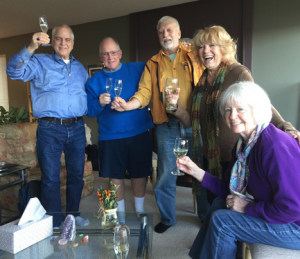
The last Bellingham meet-up of the year. Merry Christmas and Happy New Year from Cyndy (left), Steve, and Sitara…
A small and funny incident happened to my friend Len Satov and I on our way down to the last Bellingham meet-up of the year.
It had brilliant applicability to conflict resolution.
Len is the gentleman who introduced me to the ascension scenario.
He asked me to locate a rattle that happened in his car, whenever he went over a bump.
Well, we both listened and, when it occurred, I said it was coming from his side of the car.
He said, no, it was coming from my side of the car.
And we listened and puzzled but in the end both of us were sure that each was right. It was coming from his side of the car. No, it was coming from mine.
Finally one of us saw a small compartment above us in the middle of the car. In that compartment was a pair of dark glasses – that were rattling. Case closed.
There’s such a profound lesson here for conflict resolution. And I’m concerned that we’ll need a few conflict-resolution tools once we drop our financial chains and “are not going to take it any more.”

.. and more champagne to celebrate everything … being alive, abundance, soul friends along the way from Steve, Tom, Dick (not Harry), Bonita and Fran. Len is behind the camera.
So I want to furnish as many suggestions as I can before then. And the one I wanted to discuss today is polar extremes (my side/your side) vs. the nuanced middle (somewhere in the center).
Len and I were both fixated on the fact that direction meant it must be on the other person’s side. Our ears were not deceiving us. The sound was coming from “over there.”
We were really dug in. How could we possibly be wrong?
Our conceptual framework did not include the middle – which was “over there” but not all the way over there.
How many times have we had an argument along the lines … “So you don’t want to stay at the Mediterranean Villa in Pondicherry? Do you want to go on a vacation at all?” Black and white. All or nothing. Polarized and deeply dualistic.
But when we relax a little and look at the situation calmly, we find that neither of us actually favors the extreme. We simply have different nuances, emphases, or shades of meaning on a spectrum, starting from the calmness of the middle, which is the default for all of us.
Once we’ve let go of casting the other as extreme, a little negotiation, a little give-and-take usually allows us to find an amicable place somewhere in the center.

Where’s Len? Here he is.
To reach this happy conclusion, I think we need to:
(1) Stay away from the extremes and look for an accurate sense of our placement on a spectrum, starting from the middle.
See where both of us are first, marked in distance from the middle, with no attention being paid to the extreme. Let it disappear into the ethers.
(2) Negotiate from there.
I think there are several absolutely major conceptual shifts being asked of us today.
One is from “either/or” to “and.”
One is from “not of love” to “of love” (not of joy to of joy, not of peace, etc.)
And a third is from polarized and extreme arguments to explorations of relative, nuanced place on a spectrum, measured from the middle.
***
Let me share another conflict-resolution suggestion before I leave. We’re going to need good, qualified conflict-resolution specialists (I predict).
Consider having mediated calls wherever difficulty is experienced. The mediated call that I use has the complainant take the first turn. The other person listens and from time to time demonstrates that they understand what’s being said.
The listener is not writing their shopping list in their head. They don’t interrupt. The complainant has full and unimpeded opportunity to state their case completely and see that they’ve been heard.
If the complainant might feel difficulty delivering their complaint directly to the other person, I ask them to deliver their complaint to me (the mediator) with the other person listening in.
Then the recipient of the complaint has a turn and gets to say whatever they want, without interruption.
Then the complainant gets a second turn.
I’ve seldom found that discussions go on past this point, with most lightworkers.
The magic ingredient is good-quality listening and the mutuality of the experience of being heard.

